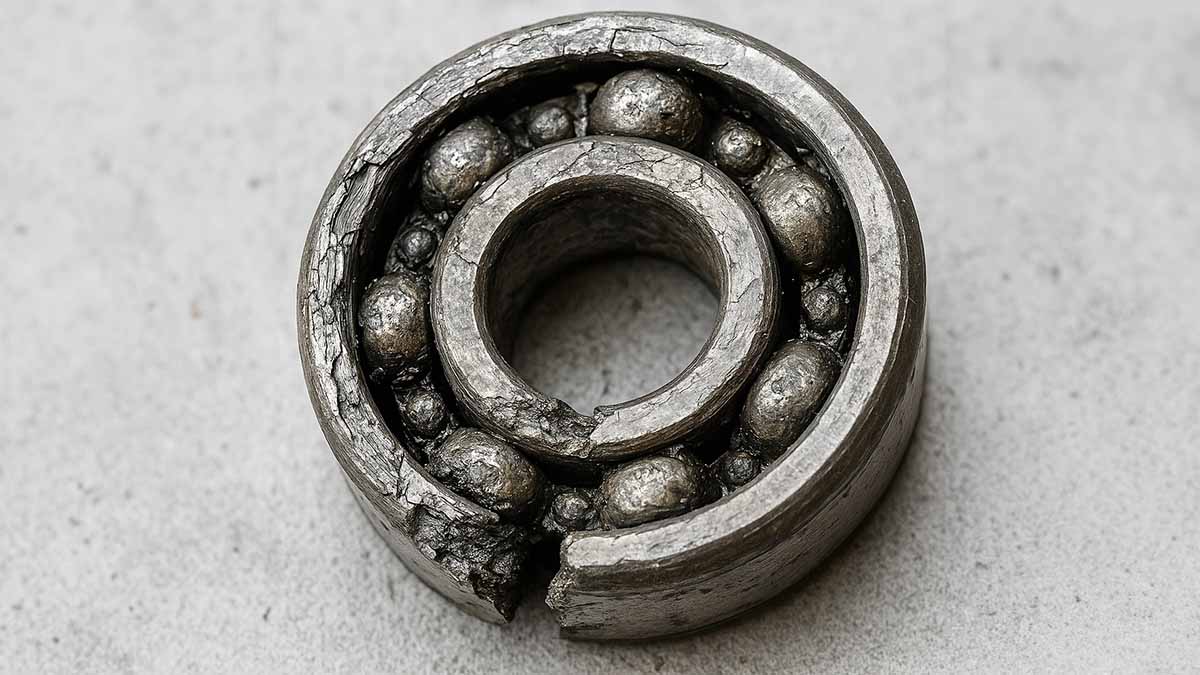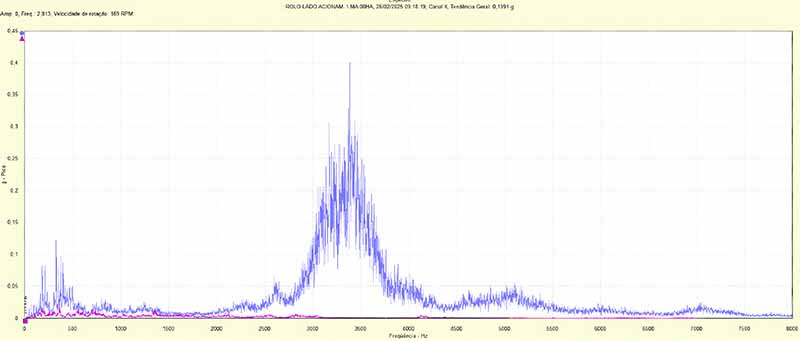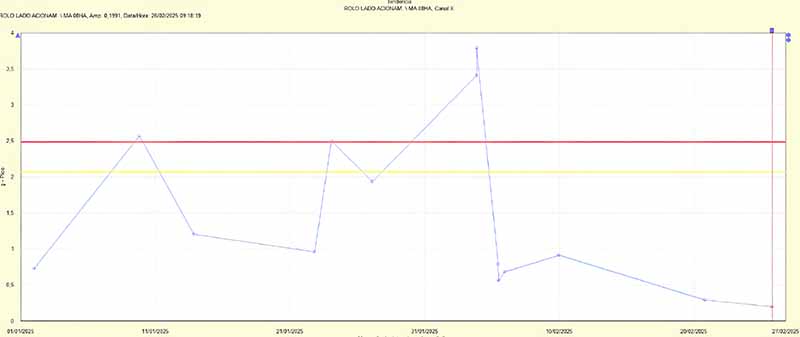Predictive maintenance plays a crucial role in industrial reliability, preventing costly downtime and unexpected failures. This case study demonstrates how vibration analysis identified a critical issue in a paper machine’s drying cylinder, enabling proactive intervention and avoiding severe operational consequences.

Early Warning Signs from Routine Monitoring
During routine vibration monitoring of a drying cylinder in a paper manufacturing plant, an elevated acceleration level was detected on the bearing (22238 C4). The initial reading of 1.9 G escalated to 3.78 G within a month, signaling rapid deterioration. Based on these findings, a planned intervention was scheduled during the next maintenance shutdown.
Spectral characteristic before intervention
Internal Damage Uncovered During Inspection
Upon disassembling the bearing housing, the maintenance team encountered severe wear and internal damage, with the following key observations:
- Significant metal debris inside the housing, indicative of advanced bearing degradation.
- Unusual wear patterns, suggesting that external factors—beyond standard operating conditions—had contributed to the failure.
- Difficult removal process, highlighting the extent of damage and reinforcing that failure was imminent.
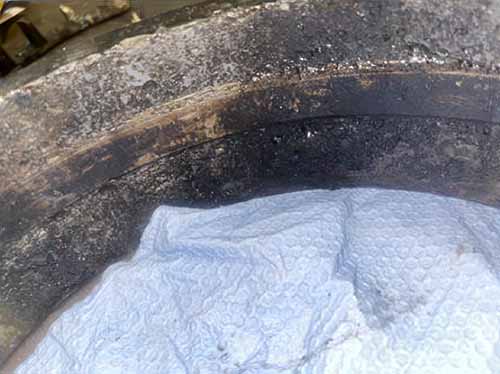
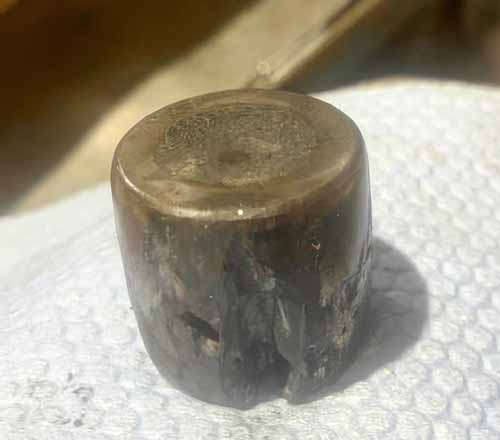
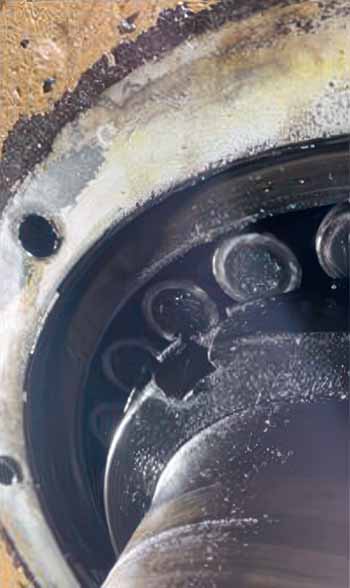
Impact of Proactive Maintenance Intervention
By acting on the vibration data, the team was able to replace the bearing before a catastrophic failure occurred. The benefits of this proactive approach included:

This intervention prevented a potential production loss, reduced maintenance costs, and ensured continued operational reliability.
Key Takeaways from the Incident
Critical Failure Prevention
Early identification of the defect was crucial to prevent more serious damage to the dryer cylinder, such as bearing and shaft failure. If the defect is not detected in time, the locking of the bearing could generate a large stop.
Operational Safety and Availability
The intervention not only solved the immediate problem but also ensured the continuity of the operation, preventing an unexpected stop and ensuring the safety of the set. Diagnosis by vibration analysis has proven to be a vital tool for optimizing predictive maintenance and the operation of rotary equipment.
Post-Intervention Performance Data
Following the scheduled intervention, post-maintenance vibration measurements confirmed a significant reduction in acceleration levels. The initial reading of 3.78 G dropped to a stable 0.6 G, indicating that the bearing replacement successfully restored normal operating conditions. These results highlight the impact of predictive maintenance in preventing unexpected failures and ensuring the long-term reliability of equipment.
Purple: the current condition after the intervention
Blue: the previous condition
Trend graph after intervention
Root Cause Investigation and Next Steps
While the bearing was successfully replaced, the severity of wear raised concerns about underlying failure mechanisms. Potential causes under investigation include:
- Misalignment
- Lubrication deficiencies
- Overloading
- Contamination
- Drive system anomalies
A comprehensive root cause analysis is underway to determine the primary driver of this failure, ensuring that similar issues can be mitigated in the future.
Misalignment Investigation of the Dryer Cylinder
Context
A pair of indicators observed in vibration analysis shows the dominant presence of the meshing frequency of a 67-tooth gear, appearing in both velocity and acceleration measurements in the horizontal and axial directions. Additionally, carpet displacement indicates friction, while velocity analysis reveals misalignment and looseness.
In the spectrum, the gear meshing frequency of the 67-tooth gear is clearly visible, with harmonics appearing in the acceleration parameter. The overall acceleration value reaches 1 Gs, which is considered high. Of this 1 Gs, approximately 0.80 Gs originates from the meshing frequencies up to the sixth harmonic, indicating that the gear meshing has a significant influence on the measured values.
Action Taken
Based on spectral analysis, an inspection of the dryers was carried out, revealing the following condition:


The images show misalignment in the gear meshing, as well as areas with macropitting or cavities, which are characteristics commonly associated with bearing damage.
Possible Causes
- Excessive overload – Forces beyond the designed limits result in high contact surface stresses. Frequent impacts or dynamic loads accelerate crack propagation.
- Lubrication issues – An insufficient lubricant film increases metal-to-metal contact. The viscosity should be evaluated.
- Lubricant contamination – Solid particles (dust, metal shavings) or chemical contaminants accelerate fatigue.
- Misalignment and geometric defects – Non-uniform contact leads to localized stresses and accelerated wear. Improper assembly can cause an increase in load in specific areas.
Potential Causes of Misalignment
- High axial loads – Helical gears generate axial forces that may cause shaft displacement if not properly supported.
- Excessive system load – When the applied load exceeds the design limits, shaft flexion and relative displacement between gears may occur.
This analysis underscores the necessity for corrective actions to prevent premature wear and ensure the system’s reliability.
Key Lessons from This Case
This case reinforces the critical role of vibration analysis in predictive maintenance. By identifying bearing wear in its early stages, the team avoided unplanned downtime, costly repairs, and potential safety risks. Ongoing monitoring and root cause analysis will further enhance asset reliability and operational efficiency.
Have you encountered similar bearing wear patterns in your industry? What strategies have you implemented to mitigate such failures? Share your insights—we welcome your expertise.

